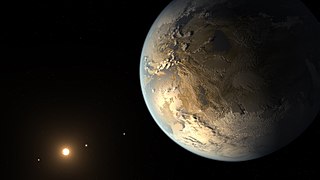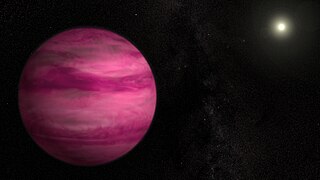Related Research Articles
The Trans-Atlantic Exoplanet Survey, or TrES, used three 4-inch (10 cm) telescopes located at Lowell Observatory, Palomar Observatory, and Teide Observatory to locate exoplanets. It was made using the network of small, relatively inexpensive telescopes designed to look specifically for planets orbiting bright stars using the transit method. The array used 4-inch Schmidt telescopes having CCD cameras and automated search routines. The survey was created by David Charbonneau of the Center for Astrophysics, Timothy Brown of the National Center for Atmospheric Research, and Edward Dunham of Lowell Observatory.
The XO Telescope is an astronomical telescope located on the 3,054 m summit of Haleakala on Maui, Hawaii. It consists of two 200-millimeter telephoto camera lenses, and resembles binoculars in shape. It is used by the XO Project to detect extrasolar planets using the transit method. It is similar to the TrES survey telescope. The construction of the one-of-a-kind telescope cost $60,000 for the hardware, and much more than that for the associated software.

These are lists of exoplanets. As of 12 July 2023, there are 5,470 confirmed exoplanets in 4,069 planetary systems, with 924 systems having more than one planet. Most of these were discovered by the Kepler space telescope. There are an additional 1,984 potential exoplanets from Kepler's first mission yet to be confirmed, as well as 977 from its "Second Light" mission and 4,405 from the Transiting Exoplanet Survey Satellite (TESS) mission.
HD 68988 is a star in the northern constellation of Ursa Major. It has been given the proper name Násti, which means star in the Northern Sami language. The name was selected in the NameExoWorlds campaign by Norway, during the 100th anniversary of the IAU. HD 68988 is too faint to be seen with the naked eye, having an apparent visual magnitude of 8.20. The star is located at a distance of 199 light years from the Sun based on parallax. It is drifting closer with a radial velocity of −69 km/s and is predicted to come as close as 78 light-years in 617,000 years.

WASP-12b is a hot Jupiter orbiting the star WASP-12, discovered on April 1, 2008, by the SuperWASP planetary transit survey. The planet takes only a little over one Earth day to orbit its star, in contrast to about 365.25 days for the Earth to orbit the Sun. Its distance from the star is only the Earth's distance from the Sun, with an eccentricity the same as Jupiter's. Consequently, it has one of the lowest densities for exoplanets. On December 3, 2013, scientists working with the Hubble Space Telescope (HST) reported detecting water in the atmosphere of the exoplanet. In July 2014, NASA announced finding very dry atmospheres on three exoplanets orbiting sun-like stars.
WASP-12 is a magnitude 11 yellow dwarf star located approximately 1410 light-years away in the constellation Auriga. WASP-12 has a mass and radius similar to the Sun and is known for being orbited by a planet that is extremely hot and has a retrograde orbit around WASP-12. WASP-12 forms a triple star system with two red dwarf companions. Both of them have spectral types of M3V and are only 38% and 37% as massive as the Sun, respectively.

Transiting Exoplanet Survey Satellite is a space telescope for NASA's Explorer program, designed to search for exoplanets using the transit method in an area 400 times larger than that covered by the Kepler mission. It was launched on 18 April 2018, atop a Falcon 9 launch vehicle and was placed into a highly elliptical 13.70-day orbit around the Earth. The first light image from TESS was taken on 7 August 2018, and released publicly on 17 September 2018.
Kepler-5 is a star located in the constellation Cygnus in the field of view of the Kepler Mission, a NASA project aimed at detecting planets in transit of, or passing in front of, their host stars as seen from Earth. One closely orbiting, Jupiter-like planet, named Kepler-5b, has been detected around Kepler-5. Kepler-5's planet was one of the first five planets to be discovered by the Kepler spacecraft; its discovery was announced on January 4, 2010 at the 215th meeting of the American Astronomical Society after being verified by a variety of observatories. Kepler-5 is larger and more massive than the Sun, but has a similar metallicity, a major factor in planet formation.

Kepler-19c is an extra-solar planet orbiting the star Kepler-19 approximately 717 light years from Earth.

Gliese 504 b is considered by NASA to be a Jovian planet and it is located in the system of the solar analog 59 Virginis, discovered by direct imaging using HiCIAO instrument and AO188 adaptive optics system on the 8.2-meter Subaru Telescope of Mauna Kea Observatory, Hawaii by Kuzuhara et al. Visually, GJ 504 b would have a magenta color. It can be seen from Earth in the constellation Virgo.

XO-6b is a transiting exoplanet, a hot Jupiter, orbiting the star XO-6 around 760 Light Years away from Earth. It was discovered in 2016 by the XO planet search team.
Qatar-1 is an orange main sequence star in the constellation of Draco.
Qatar-2 is a K-type main-sequence star about 595 light-years away. The star is much older than Sun, and has a concentration of heavy elements similar to solar abundance. The star features a numerous and long-lived starspots, and belongs to a peculiar variety of inflated K-dwarfs with strong magnetic activity inhibiting internal convection.
KOI-5 is a triple star system composed of three stars: KOI-5 A, KOI-5 B and KOI-5 C, orbiting 1,870±70 light-years away.
K2-66b is a confirmed mega-Earth orbiting the subgiant K2-66, about 520 parsecs (1,700 ly) form Earth in the direction of Aquarius. It is an extremely hot and dense planet heavier than Neptune, but with only about half its radius.
Qatar-3 is a 12th magnitude star located in the northern constellation Andromeda. It is host to a transiting planet. With a radial velocity of 10.99 km/s, it is drifting away from the Solar System, and is currently located 2,400 light years away based on its annual parallax.
The Qatar Exoplanet Survey, also known as QES, is an international exoplanet search survey based in Qatar. Its main goal is to detect exoplanets using the transit method, which is observing the light curve of the host star.
Qatar-4 is a faint K-dwarf star that hosts a planet in the constellation Andromeda. With an apparent magnitude of 13.60, it is impossible to detect with the naked eye, but can be detected with a powerful telescope. Qatar-4 is currently located 1,083 light years away based on parallax.
References
- 1 2 3 4 5 6 7 8 9 10 11 Alsubai, Khalid; et al. (2017). "Qatar Exoplanet Survey: Qatar-3b, Qatar-4b, and Qatar-5b". The Astronomical Journal. 153 (4). 200. arXiv: 1606.06882 . Bibcode:2017AJ....153..200A. doi:10.3847/1538-3881/aa6340. S2CID 119214858.
- ↑ "Qatar-5". Universe Guide. 15 September 2018. Retrieved 2019-12-27.
- ↑ "Astronomers discover three 'Qatar' exoplanets".


